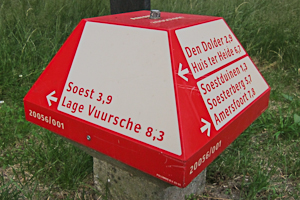Dutch cycle paths are so well signposted, that even if you might not always know precisely where you are, you can hardly get lost. Just cycle on to the next signpost which will point you in the right direction. The distances given on the signposts are in kilometres. If you don’t know the area, it can be useful to have a map so you know the location of the destinations on the signposts.
 Dutch cycle paths are so well signposted that you can hardly get lost. Photo © Holland-Cycling.com
Dutch cycle paths are so well signposted that you can hardly get lost. Photo © Holland-Cycling.com
Different types of signposting
While the regular signposts for motorists are all blue, the signposts for cyclists are red and white or green and white signposts. What's the difference?
Red and white signposts
The red and white signposts are for cyclists and moped riders. They come as conventional signposts, but in more rural areas you'll also find them in the shape of toadstools. The idea is that the toadstools blend better in the surroundings. You'll find the numbers at the bottom of the toadstool on some cycle maps.
 Toadstool shaped signpost for cyclists. Photo © Holland-Cycling.com
Toadstool shaped signpost for cyclists. Photo © Holland-Cycling.com
Green and white signposts
The green and white signposts are only for cyclists. These will usually take you along more scenic routes where mopeds are not allowed.
Green and white signposts are not only used for signing destinations. All national long-distance cycle routes (LF routes) and the numbered cycle network also are signed with green and white signposts.

